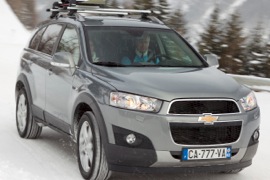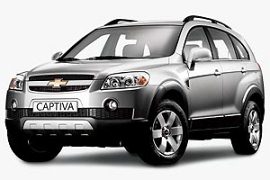CHEVROLET Captiva Models/Series Timeline, Specifications & Photos
First production year: 2006
Engines: Diesel, Gasoline
Body style: SUV (Sports Utility Vehicle)
Chevrolet tried its last shot to the European market with a re-badged version of the Opel Antara sold under the bow-tie brand with the Captiva name.
In 2006, GM introduced a new compact SUV in various markets worldwide. It was sold under multiple brands, from Chevrolet to Vauxhall and Saturn. While in some countries the car made a good impression, in others it just didn't fit. Struggling in the aftermath of the world economic crisis, Chevrolet refreshed the Captiva worldwide, including in Europe.
There was a new front fascia. Instead of the older, swept-back headlights with rounded edges, the 2011 model featured an angular, more masculine look. Antara's taller grille featured a horizontal slat that supported the bow-tie golden badge. In the back, the design team decided to install clear lenses over the taillights.
Chevrolet improved the Captiva's cabin as well. The designers installed a new instrument cluster where the fuel gauge and the coolant temperature dial were positioned between the speedometer and tachometer. A new infotainment system found its place on top of the center stack, with an improved navigation system.
GM updated the engines, and a new, 2.2-liter turbodiesel replaced the previous, 2.0-liter unit. It offered 34 more hp than its predecessor and, due to the new 6-speed automatic gearbox, it provided a lower fuel consumption. For the gasoline units, Chevrolet replaced the 3.2-liter gasoline unit with a newer, more powerful, 3.0-liter V6. But still, the car couldn't save the Chevrolet brand on the European market.
CHEVROLET Captiva 2.2L DSL AWD 6AT (163 HP)
CHEVROLET Captiva 2.2L DSL AWD 6AT (184 HP)
CHEVROLET Captiva 2.2L DSL AWD 6MT (163 HP)
CHEVROLET Captiva 2.2L DSL AWD 6MT (184 HP)
CHEVROLET Captiva 2.2L DSL FWD 6AT (163 HP)
CHEVROLET Captiva 2.2L DSL FWD 6AT (184 HP)
The Chevrolet Captiva was the Koreans’ new weapon in their attempt to conquer the European market in the compact SUV class.
Despite its American badge, the Captiva was actually made in Korea and one of its strongest points was the attractive price.
Having a large size of 4.63 m long, the Captiva featured a giant wheelbase that offered a spacious interior that could accommodate up to 7 occupants.
Inside, the cabin was cheerful and built with good quality materials. The standard equipment offered represented a good choice.
Access to the third row was easy with the bench that folded up, while the seats in the third row could be extracted from the floor by just one gesture.
The Captiva was mostly designed for larger families’ trips, as it was not in its element in the city. The SUV was fairly wide and felt uncomfortable in narrow alleys, and rather lazy under 1,7000 rpm.
In 2006, the Chevrolet Captiva was available in 3 trim levels: LS, LT and LT Special Model.
Even in the entry level version, the Captiva was well equipped with air-conditioning, power steering, power and heated exterior mirrors, speed sensitive windscreen wipers, electric windows, vanity mirrors, a tailgate glass that could be opened separately and tinted windows.
The base LS was equipped with a 2.4-liter gasoline engine and was available with a front-wheel-drive system.
Another engine option was the 2.0-lite diesel unit that developed 150 hp, enough power to move the 2 tons SUV without making it feel underpowered.

